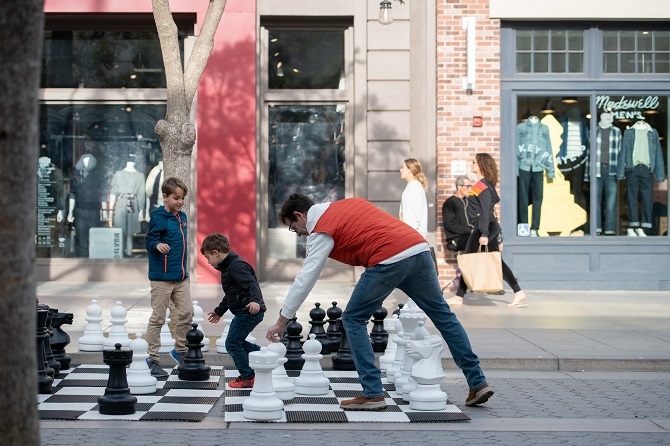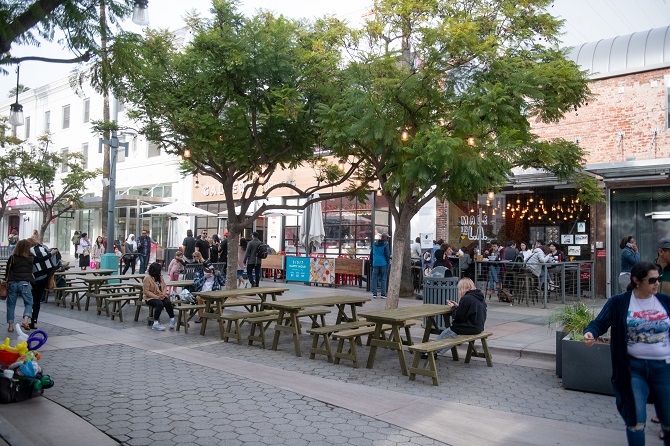Eduardo Graciano ventured to Santa Monica’s Third Street Promenade on a recent Sunday afternoon with his sons, Lucas, 6, and Davi, 5. After a brief stroll, the trio settled on a game of chess, flanked by ubiquitous street performers and a steady stream of passersby.
“It’s a nice place,” reflected Graciano of his first visit to the area as the boys rearranged the oversized figures.
The chess set is among several experiential attractions the city installed last summer to engage shoppers and entice them to stay longer.

Other recently added features include communal dining tables, colorful lounge chairs visitors can cluster as they see fit, and temporary play structures that have been a hit with the younger demographics.
The subtle but popular changes are hints at what’s to come ― the Santa Monica City Council in November directed its staff to develop Promenade 3.0, a master plan and financing strategy for the redevelopment of the area. Come March, the council will vote on whether to implement the changes.
The move comes amid declining taxable sales at the Promenade, likely a consequence of online shopping, streaming video services and food-delivery apps that have challenged traditional retail, entertainment and dining outlets.

“We were looking ahead at the trend lines and thinking the time to reimagine the future and anticipate the need for change is now while we’re kind of at the peak,” said Alan Loomis, Santa Monica’s urban designer, who is tasked with overseeing the effort for the city. “If we’re trying to respond to change when the market has bottomed out, then it’s a very, very long climb to recover.”
Sales at the Promenade dipped 10% to $435 million in 2018 from $484 million in 2015. The area generated $191 million for the first half of 2019, $2 million below the same period in 2018.
The redevelopment, set for four to five years from now, will cost between $45 million and $60 million and take up to 24 months.
The work will be funded through a public-private financial partnership, Loomis said, “which is how a lot of the Promenade’s original infrastructure from the 1980s was financed, as well as the city’s parking structures that back the Promenade.
“Property owners would vote to assess themselves through their annual taxes for a period of, say, 25 to 30 years … and then the city can bond or borrow against that future income for the upfront construction costs,” Loomis added.
Promenade 3.0
The ideas up for City Council consideration in March include treating the Promenade as a public park rather than a street, with set closing times to prevent overnight loitering and also to allow for use of digital signage.
Currently, the three-block pedestrian street, nestled between Broadway and Wilshire Boulevard, is open around the clock, has no limitations on public access, and is subject to signage and other rules that apply to other city streets.
There’s also a proposal to enhance the Promenade’s nightlife as the recent study shows pedestrian volumes peak in mid-afternoon. That proposal includes relaxing alcohol permitting regulations and expanding restaurants’ ability to offer evening entertainment.

“We would love to see a small, 50-seat speakeasy or a mezcal tasting room that would be a unique draw, but currently the only way to do that is to go through the (conditional use permit) process, which is both time- and cost-intensive,” said Steven Welliver, deputy chief executive of Downtown Santa Monica Inc., a nonprofit that works with the city to manage services and operations in the area.
“I think we want to be sensitive to the concerns of our neighbors, and that type of activity isn’t appropriate everywhere in the city. But if the Promenade is an entertainment destination, it can certainly support some nightlife-focused activities,” Welliver added.
The City Council will also consider allowing pedestrian access in alleys running parallel to the Promenade and alley-facing leasing to local or artisan businesses that cannot afford the premium rents on the Promenade.
This would aid in “diversifying the economic and retail mix of the downtown,” Loomis wrote in a November report to the City Council, adding that potential code amendments can be tested via an interim zoning ordinance.
If approved, the changes would take effect in May and will “permit the piloting of flexible regulations to understand their efficacy.”
As part of the planning for Promenade 3.0, the City Council hired Leimert Park-based Rios Clementi Hale Studios to develop a pedestrian-only streetscape configuration for the area, “complemented by a range of innovative strategies for improving the character and functionality of the Promenade,” according to the report.
Those ideas include shifting away from a traditional, linear street format and developing flexible event spaces, independent retail, food and beverage outlets, public art, and intimate gathering areas.
The experiential activities introduced last summer helped inform the ongoing design effort.
“We had the temporary stage located to the very north end of the street because we thought having a stage is an attraction to bring people to that last block, which has the lowest foot traffic,” Loomis said.
“But what we found is that even though the programming we had on the stage was relatively minor, some of the residents to the north of the Promenade … were complaining about overflow noise from the events. … And so, the primary stage then shifted to the middle block as we’re working through the design,” Loomis added.
The plan also calls for expanding DTSM’s role and responsibilities for public space management and events permitting at the Promenade, which is still routed through the city’s community and cultural services team.
“Sending event inquiries that are very specific to the Promenade into the larger pool of city event resources that have to think about spaces like the beach and the parks means that the Promenade doesn’t get this sort of specialized attention that really makes it a great event venue,” Welliver said.
Getting a consensus
The buildings that front the Third Street Promenade are held by about 50 entities, ranging from individuals and family trusts to corporate real estate firms. Obtaining a consensus on leasing and design preferences that benefit all is not easy.
“What makes the Promenade truly unique is that it feels like a street ― it doesn’t feel like it’s master planned ― it has that authenticity and a little bit of grittiness,” said Scott Schonfeld, a DTSM board member who, along with two partners, owns the Gallery Food Hall at the Promenade.
“On the other hand, that makes it extremely difficult to ensure the right mix of tenants. Each owner, when they make leasing decisions, they’re looking out primarily for what’s the best store for their building, for their investment. There are times when the best thing for that investment is the same as what’s best for the street, but I think that there are also times when people have made decisions that tend to ultimately oversaturate one aspect of retail, and then we lose out on another.”
Schonfeld would prefer to see more authentic brands alongside corporate flagships, the businesses that draw local, off-peak foot traffic. The city and DTSM organized several meetings last summer for owners to get to know each other and hash out their concerns.
“They collectively realized that if they all chase the best and the highest dollar of cellphone stores that they would lose the character (of) the street, and that it would ultimately hurt them,” Loomis said, referring to a Verizon flagship store that replaced Hard Tail boutique on the 1300 block and closed within a year.
“Collectively they have a pretty big ownership and stake in what’s happening, and they could help drive the retail concept because the city can’t dictate that.”

